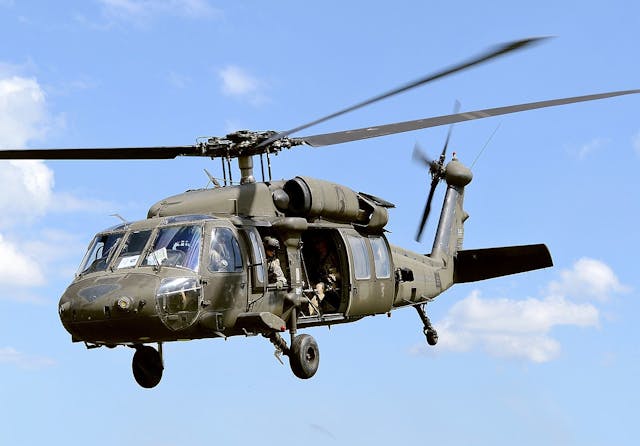Discovering the Thrills and Innovations of the Blackhawk Helicopter
The Blackhawk helicopter stands as a testimony to army aviation's advancement, combining technical advancements with functional applications. What exists ahead for this iconic aircraft, and just how will emerging innovations form its future in army operations?
History of the Blackhawk Helicopter
Considering that its creation in the 1960s, the Blackhawk helicopter has played an essential duty in modern armed forces air travel. Established by Sikorsky Airplane, the UH-60 Blackhawk was made to meet the U.S. Army's need for a flexible utility helicopter with the ability of performing a variety of missions, including troop transportation, medical evacuation, and cargo airlift. The design was an action to the constraints of earlier helicopters, particularly in regards to survivability, rate, and maneuverability.
The Blackhawk made its initial trip in 1974 and quickly entered service in 1979. Its introduction marked a significant innovation in helicopter modern technology, including a two-rotor system that boosted efficiency and security. The airplane's rugged construction and progressed avionics permitted it to run efficiently in varied atmospheres and conditions.
Throughout the years, the Blackhawk has been continuously upgraded, incorporating lessons gained from numerous battle scenarios. Its release in disputes such as the Gulf War, Somalia, and the War on Terror additional solidified its credibility as a vital possession. The Blackhawk's heritage is identified by its flexibility and durability, making it a cornerstone of army aeronautics for years.
Secret Features and Requirements
The Blackhawk helicopter is distinguished by its durable style and advanced technical attributes, which jointly enhance its functional capacities. Made mostly for utility goals, the Blackhawk boasts a maximum takeoff weight of approximately 22,000 extra pounds, allowing it to bring significant payloads while keeping dexterity.
Furnished with two General Electric T700-GE-701C engines, the Blackhawk achieves an optimal speed of around 183 knots and a variety of 368 nautical miles - Blackhawk Helicopter. Its advanced blades system features a four-blade primary blades and a four-blade tail rotor, making sure stability and ability to move in different flying problems
The helicopter's cabin can fit as much as 11 soldiers or various freight configurations, showcasing convenience in goal profiles. Furthermore, the Blackhawk is designed with sophisticated avionics, consisting of electronic trip controls and a thorough cockpit display, enhancing pilot situational understanding.
For boosted survivability, the Blackhawk integrates ballistic shield and self-sealing gas containers. Its ability to operate in varied atmospheres, from deserts to icy terrains, additionally strengthens its credibility as a reliable platform for military and humanitarian operations alike. The Blackhawk's mix of adaptability, power, and durability makes it a keystone of modern-day airborne capacities.
Advancements in Technology
Technologies in modern technology have dramatically boosted the capacities of the Blackhawk helicopter, guaranteeing it continues to be at the center of military aviation. Among visit our website one of the most significant developments is the combination of innovative avionics systems, which supply improved situational awareness via real-time information handling and display screen. This innovation allows pilots to browse complex atmospheres more efficiently, improving objective success rates.

Additionally, the intro of digital fly-by-wire systems has actually transformed the control mechanisms of the Blackhawk, giving smoother handling and enhanced responsiveness. Jointly, these technological innovations ensure that the Blackhawk helicopter continues to be a crucial property in modern army operations.
Roles in Armed Force Procedures
With sophisticated modern technology enhancing its capabilities, the Blackhawk helicopter plays a multifaceted duty in military operations. Mainly, it is used for troop transportation, allowing quick deployment and extraction of workers in numerous fight scenarios. Its large cabin can suit approximately 11 troops, making it a crucial asset for special operations and massive goals.
Additionally, the Blackhawk works as a medevac platform, furnished to move wounded soldiers quickly and efficiently from the battleground to clinical centers - Blackhawk Helicopter. Its convenience includes logistical support, where it carries materials and devices vital for maintaining army procedures in remote locations

The helicopter is also important in reconnaissance missions, providing aerial security and intelligence-gathering capabilities. Its ability to operate in varied settings-- ranging from city setups to extreme surfaces-- more strengthens its relevance on the combat zone.
In Addition, the Blackhawk can be furnished with sophisticated weapons, permitting it to involve in battle and provide close air assistance. This versatility underscores the helicopter's essential role in modern-day armed forces strategies, making it an important part of armed forces worldwide.
Future Developments and Innovations
Improvements in technology guarantee to navigate to this site usher in a brand-new era for the Blackhawk helicopter, improving its capabilities and operational performance. Future developments for the Blackhawk may consist of enhancements in avionics, such as advanced trip control systems and boosted situational awareness tools powered by man-made knowledge.
Moreover, the assimilation of unmanned systems is on the horizon, potentially enabling manned-unmanned teaming procedures that can expand goal profiles and decrease danger to employees. The Blackhawk's layout is likewise expected to incorporate lighter and stronger materials, enhancing gas effectiveness and overall performance.

Final Thought
To conclude, the Blackhawk helicopter represents a considerable accomplishment in armed forces aeronautics, characterized by its versatility and progressed technical features. Its historical advancement reflects a consistent feedback to operational needs, enhancing capacities in various functions such as army transportation and medevac procedures. Recurring technologies, consisting of the assimilation of expert system and hybrid-electric propulsion, guarantee to additional reinforce the Blackhawk's efficiency and significance in future armed forces involvements, guaranteeing its status as a crucial asset on the battleground.

With advanced modern technology enhancing its capabilities, the Blackhawk helicopter plays a diverse function in armed forces operations. (Blackhawk Helicopter)
Comments on “Why the Blackhawk Helicopter Stands Apart as a Leader in Modern Helicopter Style”